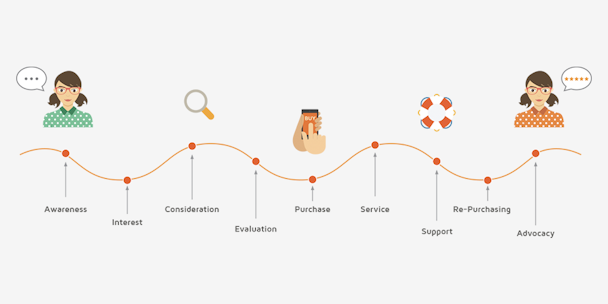What are Digital Experience Platforms (DXPs) and why they will replace CMS to ensure your business success.
You are probably familiar with CMS (content management systems), you may have even been through a couple of different CMS implementations in your organization. Likely, you will have gone through a first-generation one in the early or mid-2000s when WCM (web content management) solutions and CMS began to cater for organizations and businesses to publish content online.

user journey ez systems
Then came Web 2.0 and smartphones so websites (and the technology behind them) evolved, no longer offering up static brochureware. Around this time social media burst onto the scene, so CMS vendors adapted, and new functionalities were developed launching the next generation of CMS in the mid-2010s, very often based on Open-Source technology.
As companies have undergone digital transformation so a third generation of systems have emerged, the DXP. Designed to provide better customer experiences, DXPs are the natural evolution of your good old (or not so old) CMS, simply with much more functionality and seamless integrations giving you a new perspective in a world that has now fully pivoted to be customer centric on all fronts.
It’s first and foremost about building “Your” digital experience platform
DXP is now promoted by CMS vendors like eZ, as an umbrella term for a range of capabilities in their software stack that are complementary to each other. It is all about building digital experiences: content creation, content delivery, e-commerce, personalization and analytics. It relies on the combination of an organization: its culture, strategy and people, along with the technology platform that enables the organization to succeed with its digital business.
The goal is to help every organization to build their own platform that enables them to create, operate, maintain, govern and grow their digital operations. A platform that enables you to create and deliver the most effective digital experiences delighting your users along every step of their journey with you. Such a platform will never be the result of an “off-the-shelf” purchase based on a single all-in-one product of a single vendor.
What makes a good digital experience platform: putting the user first
A good digital experience platform is when the organizational and technological setup enables the organization to deliver outstanding experiences to its customers. Digital experiences that are smooth, easy, memorable and enjoyable at all customer touchpoints with the organization, from the initial interaction to the latest one when they have become a loyal customer and enthusiastic advocate of the brand.
Digital experiences are the sum of all digital touchpoints or interactions between you and your customers at every stage of the customer journey. This might include touchpoints on your websites, on apps, on other channels such as social media, digital signals or others.
What does it take to deliver these digital experiences?
It’s all about being able to build superior digital experiences that will give you competitive advantage in your market. You should be able to do this with speed, and repeatedly, by always improving user experiences and taking them to new heights.
When it comes to selecting the technology platform, one thing is crucial: a technology stack that orchestrates and delivers all these digital touchpoints, across multiple channels. For it to work well, it’s advisable to deploy a single technology layer to support all digital touchpoints, instead of several solutions (e.g. one global platform instead of one web CMS for editorial, one e-Commerce engine for the shopping part and one forum/community software for online support).
Note there is a big difference between a single technology to manage the experience and an all-in-one approach. In the first, the interaction layer should be unique to ensure good user experience, but it doesn’t have to deliver all features so long as it connects to other systems.
It is not much different from how modern CMS solutions have evolved. CMS vendors have long understood that they had to offer solutions that would do much more than purely managing and delivering content on pages. They have developed additional functionalities for example, to purchase products online, or to access services via websites. The vendors have also created communities where partners, developers and designers build and share add-ons and services, extending far beyond the scope of traditional content management.
When it comes to DXPs there is no well-defined functional scope. However, one thing is for sure: a DXP is more than a CMS. It has to include CMS capabilities but must offer more, and must follow a different approach. For example, one DXP might have out-of-the-box advanced e-Commerce, while another won’t. The same goes for behavioral personalization capabilities or integrated analytics. But what commonality they all to have is to provide the organization with a core foundational technology and the ability to integrate it with complementary set of technologies that enables the business build its digital platform.
If you would like to know more about our DXP software, eZ Platform, or tap into our knowledge and expertise at building transformative digital experiences. Download our latest DXP eBook now.

